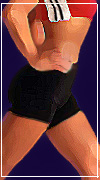Cardio

For maximum effectiveness and safety, cardiovascular exercise has specific instructions on the frequency, duration, and intensity. These are the three important components of cardiovascular exercise that you really need to understand and implement in your program. In addition, your cardiovascular program should include a warm-up, a cool-down, and stretching of the primary muscles used in the exercise.
Cardiovascular exercise should be done a minimum of three times a week, a minimum of 20 minutes per session and should be done after a 5-10 minute warm-up (at a low intensity of 50-60% of max HR) and a 5-10 minute cool-down (at a low intensity of 50-60% of max HR) should follow. Once your muscles are warm (after warm up) and after the cardiovascular exercise, you should stretch those muscles used in the exercise.
There are two ways in which you can check your heart rate during exercise. The most accurate one is to purchase a heart-rate monitor that you strap around your chest. It will give you feedback on a digital watch that tells you exactly what your heart rate is at a specific time in the exercise session. The other way to obtain your heart rate is by palpating (feeling) either the carotid artery, the temporal artery, or the radial artery. The easiest site is either the carotid or the radial artery. The carotid artery may be felt by gently placing your index finger on your neck, between the middle of your collar bone and jaw line. Palpating the radial artery is done by placing your index and middle finger on the underside and thumb-side of your wrist.
When you’re taking your heart rate you measure it in beats per minute (counting the number of beats for 60 seconds). For convenience, many people take their pulse for 6 seconds and multiply that number by 10, or simply add a 0 behind the number just obtained. So, if in 6 seconds you counted 12 beats, that would mean your heart rate was 120 beats per minute (bpm). Although counting for 6 seconds is most convenient, keep in mind that the longer the time interval used, the more accurate the results will be. For example, counting your heart rate for 30 seconds and then multiplying that number by 2 will give a slightly more accurate reading than counting your heart rate for 15 seconds and multiplying by 4, or 10 seconds and multiplying by 6. What ever time interval you use, be consistent.
No comments yet